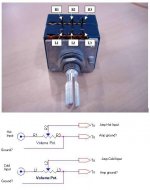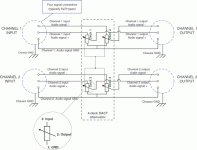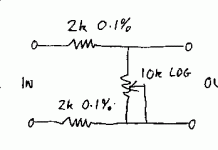Hello,
Visited the entire cyber space but could not find relevant information.
So I have a stereo ALPS and need to connect it before a balanced mono amplifier.
I suppose each row is a channel but where is In ant Out? There are 3 pins by row, numbered from 1 to 3, really!
Thank you.
Visited the entire cyber space but could not find relevant information.
So I have a stereo ALPS and need to connect it before a balanced mono amplifier.
I suppose each row is a channel but where is In ant Out? There are 3 pins by row, numbered from 1 to 3, really!
An externally hosted image should be here but it was not working when we last tested it.
Thank you.
Thank you for this one Huguini, this helps a lot!
I see what was my mistake the last time I switch on my amp with a wrong wiring... In fact the ground must go through to pin 3 and then be connected to the amp...
But in a balanced set up there's only one ground for two signal cables, so does it mean that the ground must be divided in two, connected to R3 and L3 and then R3 and L3 connected to the amp signal ground?
Something like that?
I see what was my mistake the last time I switch on my amp with a wrong wiring... In fact the ground must go through to pin 3 and then be connected to the amp...
But in a balanced set up there's only one ground for two signal cables, so does it mean that the ground must be divided in two, connected to R3 and L3 and then R3 and L3 connected to the amp signal ground?
Something like that?
Attachments
Hi Kepa,
your 2channel (stereo) pot is intended for unbalanced use.
If you buy a 4channel pot you can control both the + & - of both channels at the same time. That is what the DACT 4deck is doing.
If you are prepared to use a stereo pot on each channel and control them independantly then you can use the ALPs you already have on one channle and buy another for the second channel.
Now go back to post4 and look again at the DACT 4deck connections. Using the wiring for deck 1 & 2 only you can wire up your ALPs to exactly match this to control one balanced channel.
Notice that ground is common all the way through. your ground will also do this and pick up one pin from the ALPs (either 1 or 3, because pin2 is the wiper). + in goes to the other unused 1 or 3. + out uses wiper (pin 2) and repeat for the - connections.
your 2channel (stereo) pot is intended for unbalanced use.
If you buy a 4channel pot you can control both the + & - of both channels at the same time. That is what the DACT 4deck is doing.
If you are prepared to use a stereo pot on each channel and control them independantly then you can use the ALPs you already have on one channle and buy another for the second channel.
Now go back to post4 and look again at the DACT 4deck connections. Using the wiring for deck 1 & 2 only you can wire up your ALPs to exactly match this to control one balanced channel.
Notice that ground is common all the way through. your ground will also do this and pick up one pin from the ALPs (either 1 or 3, because pin2 is the wiper). + in goes to the other unused 1 or 3. + out uses wiper (pin 2) and repeat for the - connections.
You have a quality pot there, but I would not expect great performance from it in controlling a balanced source. Any mistracking of the resistance in the two halves (even if it is made for balanced operation) will result in poor common mode rejection (i.e. - noise), and they ALWAYS mistrack.
You'd be better off with an electronic attenuator chip or a pair of them, one for each channel. The on-chip matching is usually very good, and won't change after thousands of operations. A pot may start out OK, but after it is turned a few hundred times, it WILL mistrack and then you will lose the benefit of using a balanced line.
I_F
You'd be better off with an electronic attenuator chip or a pair of them, one for each channel. The on-chip matching is usually very good, and won't change after thousands of operations. A pot may start out OK, but after it is turned a few hundred times, it WILL mistrack and then you will lose the benefit of using a balanced line.
I_F
Ok I think I can do it now 
In fact these pots will be controling 2 subwoofers that have balanced UCD amps.
Considering what you said, it should be a good idea to set the pots to let's say 12 o'clock and adjust the volume from the digital active filter (though I know I'll lose a bit of dynamics). Or else, I could connect them unbalanced...
In fact these pots will be controling 2 subwoofers that have balanced UCD amps.
Considering what you said, it should be a good idea to set the pots to let's say 12 o'clock and adjust the volume from the digital active filter (though I know I'll lose a bit of dynamics). Or else, I could connect them unbalanced...
Ok, so this ALPS pot set up has gone a little crazy, so I've decided to go with fixed attenuator of 30db.
I'll then use the digital XO gain to control volume; this supposedly means loss of dynamics and details but I don't care much because it will only happen in the bass region.
Well, my reading has taught me that I need 1 resistor on the hot and cold rails, and 1 resistor between them.
The issue is now to set their correct value, knowing that
the XO output impedance is 160 Ohms,
and the UCD180 amp input impedance is 100 kOhms.
Any idea?
I'll then use the digital XO gain to control volume; this supposedly means loss of dynamics and details but I don't care much because it will only happen in the bass region.
Well, my reading has taught me that I need 1 resistor on the hot and cold rails, and 1 resistor between them.
The issue is now to set their correct value, knowing that
the XO output impedance is 160 Ohms,
and the UCD180 amp input impedance is 100 kOhms.
Any idea?
Interesting solution EC8010, provided that I can find a source for 0,1% resistor. 1% is no problem but I haven't seen many 0,1% type.
On the other hand, the fixed attenuator alternative looks promising, because 1. a pot will always degrade sound 2. is more expensive 3. I still have to figure out how to connect it
On the other hand, the fixed attenuator alternative looks promising, because 1. a pot will always degrade sound 2. is more expensive 3. I still have to figure out how to connect it

If you have a multimeter with 3 digits - there you go - just compare several. 10 resistors to choose from as a statistical numer at the start of your selection will do nicely.kepa1 said:Interesting solution EC8010, provided that I can find a source for 0,1% resistor. 1% is no problem but I haven't seen many 0,1% type.
On the other hand, the fixed attenuator alternative looks promising, because 1. a pot will always degrade sound 2. is more expensive 3. I still have to figure out how to connect it
Hi,
your multimeter will be more accurate on the DC volts scale than any other.
Set up a constant current source and wire your test resistors in series.
Measure the voltage drop across each and select those that make best matched pairs.
You can achieve 1 part in 1990 matching accuracy on a 3.5 digit DMM (0.05%). This is a matching accuracy not an absolute accuracy, but here you do not need absolute accuracy.
your multimeter will be more accurate on the DC volts scale than any other.
Set up a constant current source and wire your test resistors in series.
Measure the voltage drop across each and select those that make best matched pairs.
You can achieve 1 part in 1990 matching accuracy on a 3.5 digit DMM (0.05%). This is a matching accuracy not an absolute accuracy, but here you do not need absolute accuracy.
- Status
- This old topic is closed. If you want to reopen this topic, contact a moderator using the "Report Post" button.
- Home
- Design & Build
- Parts
- How to connect a pot balanced


